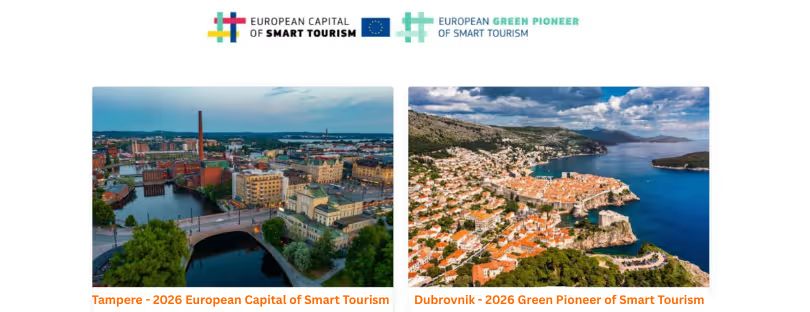
Tampere and Dubrovnik Named Europe’s Smart Tourism Leaders for 2026
Tampere (Finland) and Dubrovnik (Croatia) just earned two of Europe’s most meaningful tourism titles for 2026—European Capital of Smart Tourism and European Green Pioneer of Smart Tourism—after the European Jury met in Brussels on 18–19 November 2025. And while awards in the tourism world happen often, these two matter. They aren’t about marketing slogans or glossy brochures; they recognize real, evidence-based progress in digitalisation, sustainability, accessibility, and creative tourism development—the four pillars the EU has been pushing hard across its tourism agenda.
It was also the most competitive year so far: 58 destinations from 22 countries entered, a notable jump that shows just how much tourism innovation has accelerated across Europe. From those, 15 shortlisted destinations travelled to Brussels to pitch their strategies, prove their impact, and show the jury how they plan to use the 2026 title to drive long-term change.
And among all of them, Tampere and Dubrovnik stood out—but for very different reasons.
Why Tampere Took the European Capital of Smart Tourism Title
If there’s one thing Tampere proved in Brussels, it’s that a mid-sized city can think big and still feel human. The jury highlighted the city’s strong performance across all categories, but two points clearly made the difference: consistency and clarity. Tampere didn’t rely on flashy one-off projects; it presented a genuinely integrated tourism vision.
One part of that vision is how the city treats tourism as a tool for local well-being rather than simply an economic engine. Tampere’s message was simple: tourism should make life better for the people who live here. Their pitch showed digitalisation improving sustainability, storytelling shaping visitor expectations before arrival, and new accessibility investments making the city easier to navigate for all travellers.
The plans for 2026 are ambitious but grounded—from smart mobility pilots to inclusive cultural programming. Tampere also delivered a strong “EU legacy narrative,” positioning itself as a role model willing to share knowledge and learnings with other cities. At a time when many destinations struggle with fragmentation in policy and communication, that’s a valuable asset.
Why Dubrovnik Became the 2026 Green Pioneer
Dubrovnik’s selection as the European Green Pioneer of Smart Tourism should surprise no one who’s been following the city’s transformation. Just a few years ago, Dubrovnik was a poster child for overtourism debates—cruise ship congestion, strained local infrastructure, and seasonal overcrowding.
Now, it’s a case study in what data-driven governance can do.
The jury praised Dubrovnik for its pioneering sustainability framework, particularly its use of real-time data to manage visitor flows and support long-term planning. This includes crowd-monitoring systems, timed entry initiatives, predictive modelling for peak seasons, and policies built with direct community input.
The city’s approach isn’t just “green” in marketing terms — it’s measurable. Dubrovnik is showing other coastal and heritage destinations that sustainability doesn’t mean reducing tourism; it means managing it smartly so the city stays liveable and the experience stays meaningful. For destinations facing cruise-related pressures—from Palma de Mallorca to Dubrovnik’s Adriatic neighbors—this is the model to watch.
The EU’s Message: Tourism Must Get Smarter, Greener and More Connected
Apostolos Tzitzikostas, European Commissioner for Sustainable Transport and Tourism, used this year’s announcement to underline a wider EU push: Europe wants to remain the world’s leading tourism destination, but it wants to earn that status responsibly.
“By investing in sustainability and digital innovation, we are ensuring that Europe remains not only the world’s leading destination but also the most responsible,”
he said — and that’s not just rhetoric. EU tourism policy since 2020 has shifted toward resilience, green transition, digital readiness, and community engagement. These awards function as both recognition and a roadmap.
The winners will receive a custom-designed EU award sculpture, promotional support, and—perhaps the most valuable perk — entry into a growing network of smart tourism cities. For the EU, this network is becoming a kind of innovation lab: cities sharing solutions, comparing data, and avoiding the “reinvent the wheel” problem that slows down tourism policy.
The latest “Leading Examples of Smart Tourism Practices in Europe” reports show how much experimentation is happening — from climate-neutral mobility in Central Europe to digital heritage tools in Southern Europe. The EU Smart Tourism Podcast also keeps these ideas accessible to policymakers and local tourism boards, who are increasingly using these resources as benchmarks.
What These Wins Mean for Europe’s Tourism Future
Europe’s tourism landscape is changing fast. Destinations aren’t only trying to attract more visitors—they’re trying to manage them better, reduce environmental pressure, and deliver higher-quality experiences. That aligns with global trends: the UNWTO reported in 2025 that destinations investing in digitalisation and sustainability saw higher visitor satisfaction and better resilience during seasonal fluctuations.
In many ways, Tampere and Dubrovnik represent two sides of the same shift. Tampere shows how tech-forward cities can build tourism ecosystems that support well-being and local identity. Dubrovnik shows how high-pressure destinations can use data and policy to move from overcrowded to future-proof.
They also join previous winners like Seville, Pafos, Helsinki, and Karlsruhe — all of which used the title to accelerate bigger changes, from mobility innovation to cultural regeneration. Expect Tampere and Dubrovnik to follow, and likely expand the EU’s growing body of replicable tourism solutions.
Where Tampa and Dubrovnik Stand Compared to Similar Players
Compared with cities like Ljubljana, Copenhagen, or Valencia — all major European sustainability leaders — Tampere’s balanced approach between wellbeing, heritage and digital innovation positions it as a rising Nordic smart tourism competitor. Meanwhile, Dubrovnik’s transformation places it in the same circle as destinations like Barcelona or Amsterdam, which have turned to policy and technological controls to reduce pressure and protect local life.
Reliable sources such as UNWTO, the European Travel Commission, and EU Smart Tourism Initiative reports consistently emphasise the same direction: data-driven management, local engagement, and innovation ecosystems will define the next decade of European tourism.
Tampere and Dubrovnik didn’t just win because they have good ideas; they won because their ideas align with where tourism is heading globally.
Quick Travel Tips for Visiting Tampere and Dubrovnik
Tampere, Finland
- Nearest airports: Tampere-Pirkkala Airport is just 20 minutes from the city; Helsinki Airport is a 1h30 train ride.
- Transport tips: The city’s tram network is excellent and easy for visitors; digital tickets via the Nysse app are a must.
- Where to stay: Lapland Hotels Tampere is ideal for city explorers; Solo Sokos Hotel Torni offers great views; budget-friendly Omena Hotel is centrally located.
- Ticketing: Museum and attraction passes can be booked online and often include transport—good value if you plan a cultural-heavy visit.
Dubrovnik, Croatia
- Nearest airport: Dubrovnik Airport is 25 minutes from the Old Town; shuttle buses run regularly.
- Transport tips: The Old Town is car-free—expect stairs and narrow streets. Local buses are reliable, and ferry connections are great for island-hopping.
- Where to stay: Hotel Excelsior for luxury, St. Joseph’s Boutique Hotel inside the Old Town for charm, or Lapad-area hotels for quieter stays.
- Ticketing: Buy Dubrovnik Pass online for access to city walls and museums; timed entry helps avoid peak crowds.
Conclusion: Why These Wins Actually Matter
Awards alone don’t transform destinations—but the systems behind them do. What Tampere and Dubrovnik have built reflects broader global tourism trends: data-led management, community-first planning, and sustainability that’s not symbolic but operational. As reliable analyses from UNWTO, ETC, and the European Commission repeatedly point out, destinations that combine digital readiness with environmental resilience are outperforming those that don’t.
These two winners aren’t just symbolic choices—they’re signals. Europe’s tourism future belongs to cities that can prove impact, collaborate openly, and adapt quickly. If Tampere and Dubrovnik continue on their current trajectory, they won’t just be 2026’s smart tourism leaders; they’ll be blueprints for the next decade of European travel.










